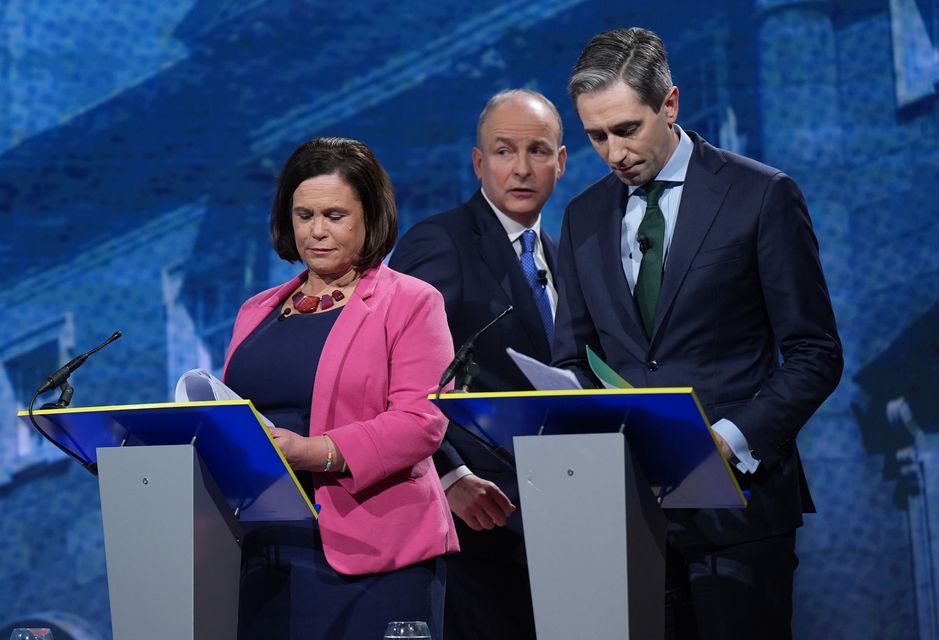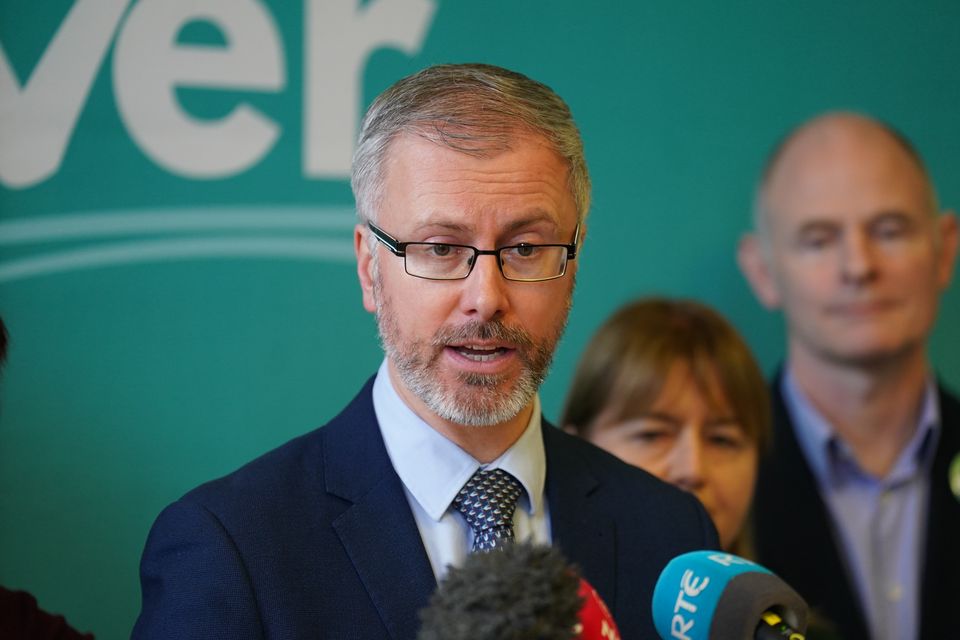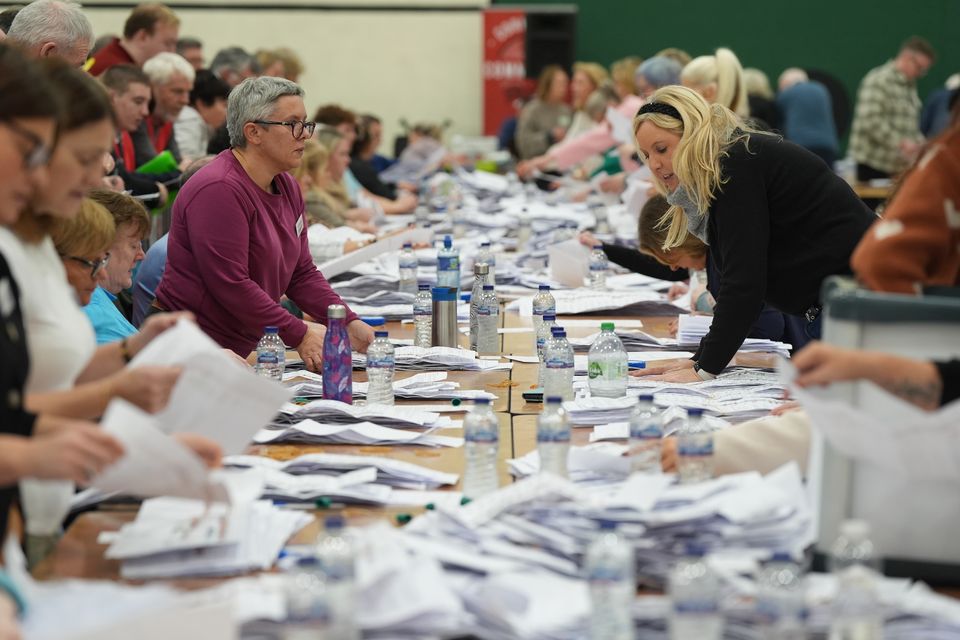Informal tallying of votes in count centres for Ireland’s General Election have suggested the potential for new breakthroughs and trouble for some established incumbents, after an exit poll put the three main parties nearly neck and neck.
The tallies, carried out by party activists and volunteers as boxes opened at 9am, give a more localised sense of the potential result than Friday night’s exit poll.
The largest opposition party Sinn Fein held 21.1% of first-preference votes, narrowly ahead of current coalition partners Fine Gael and Fianna Fail at 21% and 19.5% respectively, according to the Ipsos B&A Exit Poll commissioned by RTE, The Irish Times, TG4 and Trinity College Dublin.
Sinn Fein leader Mary Lou McDonald, Tanaiste and Fianna Fail leader Micheal Martin and Taoiseach and Fine Gael leader Simon Harris at the final TV leaders’ debate (Niall Carson/PA)
With boxes now open, the votes must first be sorted before counting formally begins in a process which could last days because of Ireland’s complex system of proportional representation with a single transferable vote (PR-STV), where candidates are ranked by preference.
It means the voting slips need to be counted several times, an undertaking which can last days.
The inconclusive early indications have turned the focus of speculation to the tricky arithmetic of government formation, as the country’s several smaller parties and many independents potentially jockey for a place in government.
First counts which carry the potential for the election of new members of parliament, known as TDs in Ireland, are expected later on Saturday.
The tallies suggest potential trouble for Fianna Fail in Wicklow, where the party’s only candidate in the constituency Health Minister Stephen Donnelly is considered to have a battle ahead, with the risk of losing his seat.
Green leader Roderic O’Gorman, who is the head of the junior partner in the outgoing coalition, is also at risk. He had 7% of the votes in the unofficial poll with more than half of boxes already tallied by midday.
Green leader Roderic O’Gorman speaking during a press conference (Brian Lawless/PA)
Elsewhere, there is significant focus on independent candidate Gerard Hutch, who is sitting on fourth in the four-seat constituency of Dublin Central after the completion of the unofficial tallies there.
Last spring, Mr Hutch was found not guilty by the non-jury Special Criminal Court of the murder of David Byrne, in one of the first deadly attacks of the Hutch-Kinahan gangland feud.
Mr Byrne, 33, died after being shot six times at a crowded boxing weigh-in event at the Regency Hotel in February 2016.
A Special Criminal Court judge described Mr Hutch, 61, as the patriarchal figurehead of the Hutch criminal organisation and said he had engaged in “serious criminal conduct”.
The constituency will be closely watched as other hopefuls wait to see if transfers from eliminated candidates may eventually rule him out of contention.
It initially appeared unlikely that only one smaller party would be needed to act as a kingmaker to seal a majority.
Counting takes place at Nemo Rangers GAA Club in Cork after voters went to the polls to elect 174 TDs across 43 constituencies (Jacob King/PA)
It has turned eyes to the possibility that a coalition could potentially be formed with four parties or with the use of independents – considered by some to be a recipe for unstable governance.
The leaders of Fianna Fail and Fine Gael have consistently ruled out entering into a coalition with Sinn Fein, citing substantial differences on policy.
As such, the opposition party faces a much more challenging route to forming a government.
However, long-held and ostensibly insurmountable political differences have eroded as recently as 2020, when the general election also delivered an inconclusive result.
Then, Fine Gael and Fianna Fail, two parties forged from opposing sides of Ireland’s Civil War of the 1920s, agreed to set aside almost a century of animosity and share power for the outgoing coalition, after similar pledges against forming coalitions had been made before the final results.
In that election, Sinn Fein won the popular vote but a failure to run enough candidates meant it did not secure sufficient seats in the Dail to give it a realistic chance of forming a government.
A key factor in determining the final result of any Irish election is the transfer of votes based on a voter’s preferences, a key part of PR-STV.
It is through this system that candidates can still claim a seat after insufficient votes following a first count.
More than 3.6 million people were registered to vote in the election to choose their representatives across 43 constituencies, in a campaign that has focused on the country’s housing crisis, the response to a dramatic increase in immigration, and economic management for the cost of living, as well as potential future trade shocks.
There are a total of 174 seats in the country’s parliament to be filled, more than ever before.
As the Ceann Comhairle, the speaker of the house, is automatically returned, 173 seats will be filled in the counting process.


